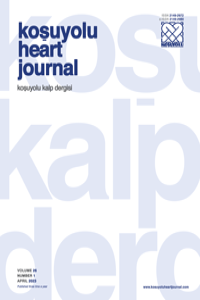Clinical Characteristics and in-Hospital Outcomes of Patients Undergoing Left Atrial Appendage Closure
Öz
Introduction: Percutaneous left atrial appendage closure (LAAC) is considered in patients with non-valvular atrial fibrillation (AF) who cannot receive long-term anticoagulant therapy or who experience thromboembolism despite anticoagulant therapy. The structural feature of the left atrial appendage (LAA) and high variability of the clinical features of the patients endorse the difficulty of the procedure. In this study, it was aimed to present our single-center LAAC experience and in-hospital follow-up results of the patients.
Patients and Methods: Patients who had undergone LAAC in our cardiology clinic between 2017 and 2022 were included in the study retrospectively. All clinical, laboratory and imaging characteristics of the patients and in-hospital follow-up results were evaluated.
Results: Median age of 29 patients included in the study was 78 years (65-82, IQR= 25-75) and 17 were males (58.6%). Median score of CHA2 DS2 -VASc was 4 (4-6, IQR= 25-75). In addition, median value of the HASBLED score was 3 (3-4, IQR= 25-75). The rate of complete closure, minor bleeding during the procedure, and pericardial tamponade were 27 (93.1%), 1 (3.4%), and 1 (3.4%) respectively, and the device was dislocated immediately after the procedure in one patient (3.4%). The most common type of LAA appendix was chicken wings 15 (51.7%).
Conclusion: Success rate of the LAAC procedure was high in this single-center study conducted in our country with a relatively high number of patients.
Anahtar Kelimeler
Kaynakça
- 1. January CT, Wann LS, Alpert JS, Calkins H, Cigarroa JE, Cleveland JC Jr, et al. 2014 AHA/ACC/HRS guideline for the management of patients with atrial fibrillation: A report of the American College of Cardiology/ American Heart Association Task Force on practice guidelines and the Heart Rhythm Society. Circulation 2014;130(23):199-267.
- 2. Kirchhof P, Benussi S, Kotecha D, Ahlsson A, Atar D, Casadei B, et al. 2016 ESC guidelines for the management of atrial fibrillation developed in collaboration with EACTS. Eur Heart J 2016;37(38):2893-962.
- 3. Benjamin EJ, Muntner P, Alonso A, Bittencourt MS, Callaway CW, Carson AP, et al. Heart disease and stroke statistics-2019 update: A report from the American Heart Association. Circulation 2019;139(10):e56-528.
- 4. January CT, Wann LS, Calkins H, Chen LY, Cigarroa JE, Cleveland Jr JC, et al. 2019 AHA/ACC/HRS focused update of the 2014 AHA/ACC/HRS guideline for the management of patients with atrial fibrillation: A report of the American College of Cardiology/American Heart Association Task Force on Clinical Practice Guidelines and the Heart Rhythm Society in Collaboration With the Society of Thoracic Surgeons. Circulation 2019;140(2):125-51.
- 5. Hylek EM, D’Antonio J, Evans-Molina C, Shea C, Henault LE, Regan S. Translating the results of randomized trials into clinical practice: The challenge of warfarin candidacy among hospitalized elderly patients with atrial fibrillation. Stroke 2006;37(4):1075-80. [Crossref]
- 6. Kuno T, Takagi H, Ando T, Sugiyama T, Miyashita S, Valentin N, et al. Oral anticoagulation for patients with atrial fibrillation on long- term hemodialysis. J Am Coll Cardiol 2020;75(3):273-85.
- 7. Pisters R, Lane DA, Nieuwlaat R, de Vos CB, Crijns HJ, Lip GY. A novel user-friendly score (HAS-BLED) to assess 1-year risk of major bleeding in patients with atrial fibrillation: The Euro Heart Survey. Chest 2010;138(5):1093-100.
- 8. Reddy VY, Sievert H, Halperin J, Doshi SK, Buchbinder M, Neuzil P, et al. Percutaneous left atrial appendage closure vs warfarin for atrial fibrillation: A randomized clinical trial. JAMA 2014;312(19):1988-98.
- 9. Holmes DR Jr, Kar S, Price MJ, Whisenant B, Sievert H, Doshi SK, et al. Prospective randomized evaluation of the Watchman left atrial appendage closure device in patients with atrial fibrillation versus long-term warfarin therapy: The PREVAIL trial. J Am Coll Cardiol 2014;64(1):1-12.
- 10. Reddy VY, Doshi SK, Kar S, Gibson DN, Price MJ, Huber K, et al.; PREVAIL and PROTECT AF Investigators. 5-year outcomes after left atrial appendage closure: From the PREVAIL and PROTECT AF trials. J Am Coll Cardiol 2017;70:2964-75.
- 11. Lakkireddy D, Thaler D, Ellis CR, Swarup V, Sondergaard L, Carroll J, et al. Amplatzer amulet left atrial appendage occluder versus watchman device for stroke prophylaxis (Amulet IDE): A randomized, controlledtrial. Circulation 2021;144(19):1543-52.
- 12. Camm AJ, Kirchhof P, Lip GYH, Schotten U, Savelieva I, Ernst S, et al. Guidelines for the management of atrial fibrillation. Euro Heart J 2010;31:2369-429.
- 13. Lip GY, Nieuwlaat R, Pisters R, Lane DA, Crijns HJ. Refining clinical risk stratification for predicting stroke and thromboembolism in atrial fibrillation using a novel risk factor based approach: The Euro Heart survey on atrial fibrillation. Chest 2010;137:263-72.
- 14. Di Biase L, Santangeli P, Anselmino M, Mohanty P, Salvetti I, Gili S, et al. Does the left atrial appendage morphology correlate with the risk of stroke in patients with atrial fibrillation? Results from a multicenter study. J Am Coll Cardiol 2012;60:531-8.
Ayrıntılar
| Birincil Dil | İngilizce |
|---|---|
| Konular | Klinik Tıp Bilimleri |
| Bölüm | Araştırma Makalesi |
| Yazarlar | |
| Yayımlanma Tarihi | 21 Mart 2023 |
| Yayımlandığı Sayı | Yıl 2023 Cilt: 26 Sayı: 1 |

